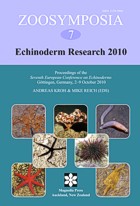Abstract
A comparative systematic survey of fossil Mesozoic laetmogonid sea cucumbers (Elasipodida) and their relatives is presented. A re-examination of the fossil record shows that only 13 fossil taxa can be recognised as belonging to this group. Four further known ‘laetmogonid’ taxa can be regarded as incertae sedis. An analysis of the results supports the following taxonomic changes. Palaeocaudinidae Boczarowski, 2001 represents a junior synonym of the Laetmogonidae Ekman, 1926. The subfamily Staurocaudininae Boczarowski, 1997 is restricted to the type species of Staurocaudina. The new family Palaeolaetmogonidae comprises probable stem group members of the Laetmogonidae. Three new species (Palaeocaudina rugia, Priscolaetmogone oloughlini, Palaeolaetmogone frankwiesei) are described from Late Cretaceous sediments of Europe. Two new genera (Palaeolaetmogone, Priscolaetmogone) are erected. The geographic distribution and phylogenetic relationships of Mesozoic and Cenozoic laetmogonid holothurians are analysed and discussed.

